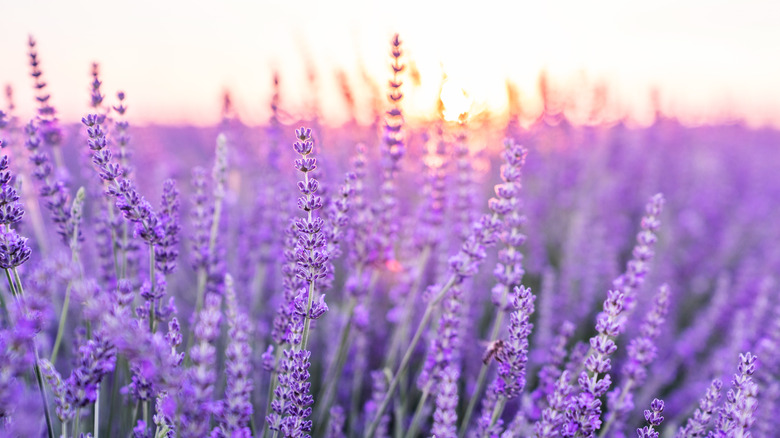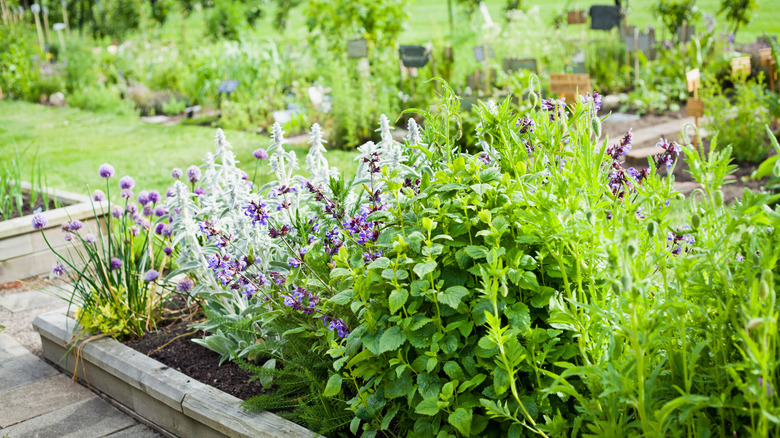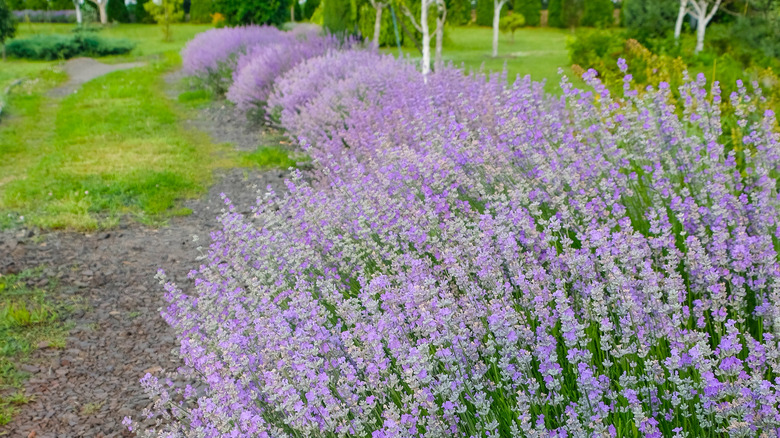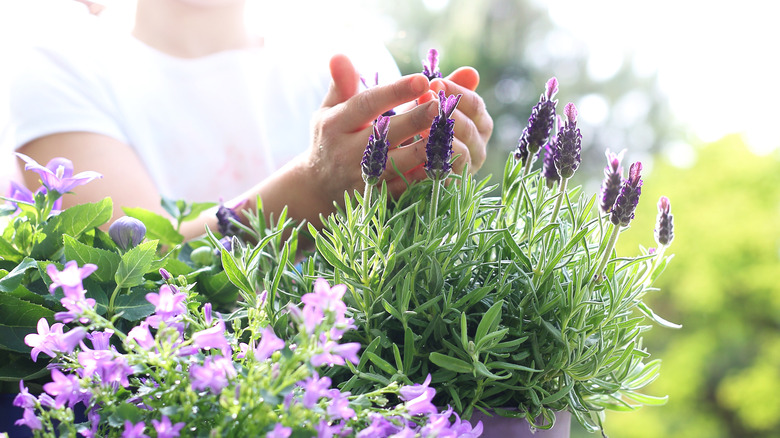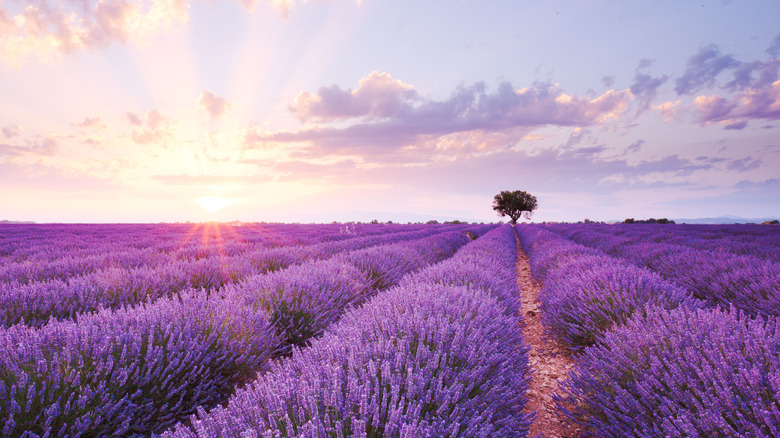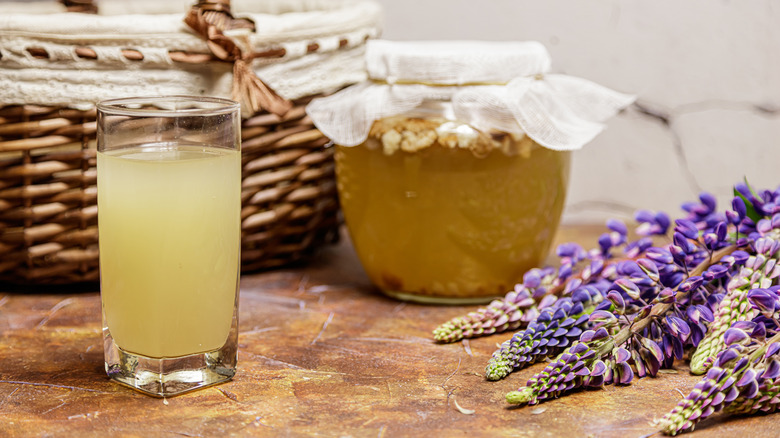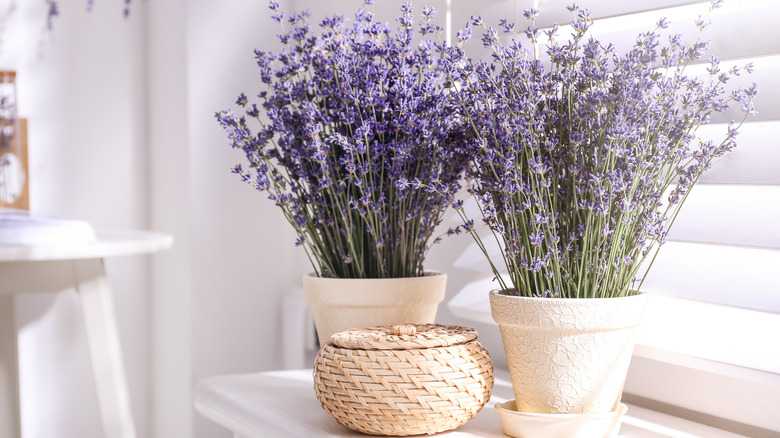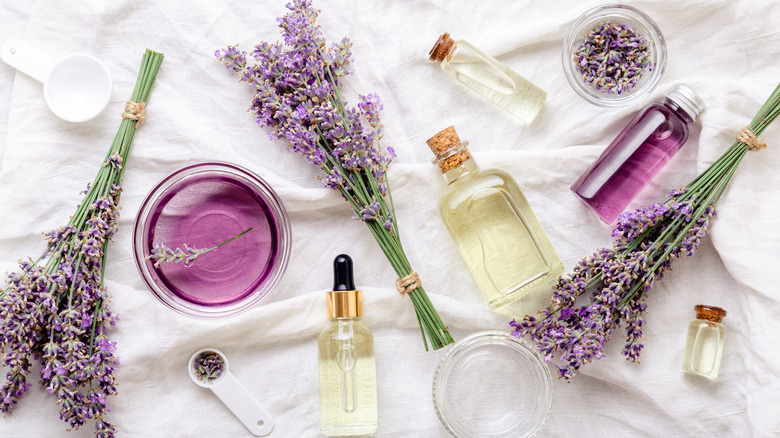Lavender: Everything You Need To Know Before Planting
Lovely and aromatic, lavender (Lavendula spp.) is a therapeutic herb that has been lauded for supporting the well-being of our bodies and minds for over 2,500 years. Often applied in the form of essential oils, soaps, cleaners, and perfumes, lavender is a versatile, herbaceous perennial plant. According to High Country Gardens, lavender, or lavare, a Latin word meaning "to wash," originated in the western portion of the Mediterranean. Ancient Romans especially loved using the soothing effects of lavender in their bathing and washing routines. Not only is it beloved in skincare, but it's also a staple in landscaping and gardening.
Famously synonymous with the French countryside, lavender generally grows 2 to 3 feet tall and 2 to 4 feet wide. It also comes in a few varieties with flowery stems that showcase various colors, including blue-violet, lilac, pink, and white. Why plant lavender? This historic herb is a garden staple. According to Gardening Know How, lavender is an easy-going purple plant to cultivate if you have the right kind of climate. It needs to be in an arid environment, along with full sun and well-drained soil. And although the herb loves the heat of the sun, it dislikes humid climates and overly wet soil. If you want to learn more about how to plant and grow lavender in your garden, read on!
How to use lavender in the garden
Lavender's use in the garden is just as lavish as its scent. Consider planting your lavender in the front yard to add curb appeal or include it in your eclectic herb garden. Either way, it will contribute to your landscape's lovely splendor. Lavender blooms mainly in summer, which is a plus since it's a natural mosquito repellent, as per Garden Design. It also looks exquisite when placed in charming pots or along borders and walkways. Wherever you decide to showcase it, your outdoor space will benefit from the natural pollinators attracted to its violet flowers, such as honey bees and butterflies (via American Meadows).
After deciding where to plant your lavender, be wary of how close you place it next to other vegetation. If you put your blue-violet near a plant that requires more attention, then one of them may end up on the decline, notes Gardening Know How. For example, vegetables require more moisture in their soil than lavender, so planting it in a planter next to the vegetables, rather than in the ground, would be best. If you're looking for plant companions to lavender, then aster, echinacea, baby's breath, sedum, and drought-tolerant roses are all great picks.
How to grow lavender
Before planting lavender, determine which USDA plant hardiness zone you reside in. Lavender is most hardy in USDA zones 5 to 8, per The Spruce. The best time to plant for zones 1 to 6 (cold climates) is spring or early summer. In warmer zones (7 to 10), plant in early fall. The roots will be able to establish themselves during the dampness of the winter months. Lavender's best conditions include warm, dry air, well-drained soil, and full sunlight (6 to 8 hours). When planting lavender in the ground, it likes room to breathe. Space your sections 1 to 3 feet apart, promoting good air circulation. Then, dig a hole that's twice as deep and wide as your lavender's root ball size. The soil should be moderately rich and alkaline.
Organic compost isn't necessary to add, but a little won't discourage its growth (via Gardening Know How). On the surface, try adding light-colored mulch, shells, stones, or pebbles to help maintain a dry atmosphere for your plant. If you're planting lavender seedlings, preferably use a smaller-sized pot. As lavender has shallow roots, the average spread of its root system is approximately 8 to 10 inches, per Southern Living. The seeds are slow to propagate, but you can plant them in light soil in your container of choice. Keep the dirt moist but not soggy. Once you see sprouts emerge, position them to receive plenty of sunlight.
How to care for lavender
Once you've established your lavender, the plant becomes officially low maintenance. It's very drought resistant and won't need to be watered as often as some of your other garden plants. Water it generously once every two to three weeks within the first year until flowering appears, then once or twice a week until fall, per Farmer's Almanac. Overwatering may lead to root rot. If planted by seed, you'll know your lavender is ready to be transplanted when it reaches approximately 3 inches tall; this may take several months. From there, it may grow several inches a year. Look for it to flower in the second or third year following the initial transplant.
Pruning is a vital component of maintaining your lavender's size and shape. Trimming it into a dome shape is ideal for its progression. Start by pruning any dead flowers, then cut about 1/3 of its stem. With low growing varieties, trim 2 to 3 inches above where the stem changes color, recommends The Spruce. Never trim as low as the wood base; lavender's wood is fragile and won't grow back once cut. Prune within the second year of its growth and do so once or twice a year. What about fertilizer? Little to no fertilizer is required. Too much of it will hinder its overall development. SF Gate suggests using a low nitrogen fertilizer when poor soil is involved. This will give it a boost towards blooming appropriately.
Lavender varieties
When you think of lavender, the lovely fields of Provence, France, or a beautiful English garden may come to mind, but there are more varieties of lavender than you might think. Currently, there are over 45 various species known with over 450 varieties, according to the United States Lavender Growers Association. Here are five main types of lavender varieties:
- English lavender (Lavandula angustifolia) – Also known as Common Lavender, this is the most cold-resistant variety (hardy in zones 5 to 9). A native of the Mediterranean, it is notably seen in the fields of Provence.
- French lavender (Lavandula dentata) – Native to Eastern and Southern Spain, this lavender has an aromatic scent resembling rosemary. It blooms most of the year and is hardy in zones 8 to 9.
- Portuguese lavender (Lavandula latifolia) – Also called Spike Lavender, this western Mediterranean lavender has a strong, pungent fragrance and has a soft lilac color. It's grown in zones 6 to 8.
- Lavandin (Lavandula x intermedia) – A hybrid lavender that combines the cold hardiness of English lavender (Lavandula angustifolia) with the warmth of Portuguese lavender (Lavandula latifolia). These are lovely to plant in mass quantities for borders and hedges. Zones 5 to 9.
- Spanish lavender (Lavandula stoechas) – This lavender has unique upright purple flower petals with a distinctive pinecone shape on the end. It is often used for making essential oils. Also known as French or Butterfly Lavender, it is hardy in zones 8 to 9.
Is lavender toxic?
Lavender is primarily safe for humans to use and ingest when appropriate, as in baking. This includes the fragrant stems. However, sipping large amounts of lavender oil is not advised, especially in small children. The aromatic herb may have more of a negative effect on animals and pets, too. Lavender contains a compound called linalool, a colorless oil classified as a monoterpenoid, per Healthy Paws. Linalool is considered toxic to dogs and cats, yet only small amounts of linalool exist in lavender itself. Your pets need to consume large quantities of the plant to make them sick. Such symptoms may include gastrointestinal, loss of appetite, fever, swollen abdomen, and potential vomiting. This is only if your pets have eaten lavender or potpourri. If they have ingested lavender essential oil, especially cats, take them to the vet right away for an examination.
As for aromatherapy, there have been reports that lavender essential oil can help your dog with anxiety and depression. You might use the oil topically for irritated skin or by adding a few drops of oil on your dog's collar or bedding. Remember to use pet-safe products and be aware of potential allergic reactions.
How to repot lavender
Is it time to repot? Each year in late winter or early spring is the best time to repot or transfer your already established lavender. Choose another well-draining container that is somewhat bigger than its current one and remove the plant by sliding it out gently. A new pot that provides a snug space for the root ball is preferable, The Spruce says. Although potted lavender requires more water than garden plants, a container too large will invite excessive moisture and inevitably hinder the plant. Always water at the base of the plant, avoiding the foliage.
You may add fertilizer at this time if needed. Incorporate 1 tablespoon of all-purpose fertilizer or compost into a few inches of the potting soil, per SF Gate. Not all lavender may be suitable for transplanting, but make sure your genus is well founded. Additionally, if you decide to bring your potted lavender inside for the winter, make sure it still gets the right amount of sun (6 to 8 hours).
Medicinal uses of lavender
There are endless benefits to having lavender in your garden, from aesthetic to medicinal purposes. One of the most popular is aromatherapy. You can make a simple DIY essential oil with the lavender you have planted. Place dry or fresh leaves in a dark jar that comes with a secure seal. Fresh blooms will be more potent. Expert landscape designer and horticulture writer Marci Degman tells eHow Food to pick the flowers before they fully bloom.
From there, fill the jar with the oil of your choice. This could be almond, avocado, olive, grape seed, sunflower, or argan oil. Incorporate a food-grade oil if you want to use it for cooking and baking. Infuse the lavender flowers, cover, and seal. To achieve the right amount of essence, take out the lavender after a week and replace it with new sprigs. Otherwise, you can let the jar rest for a couple of months, preferably in a warm place.
